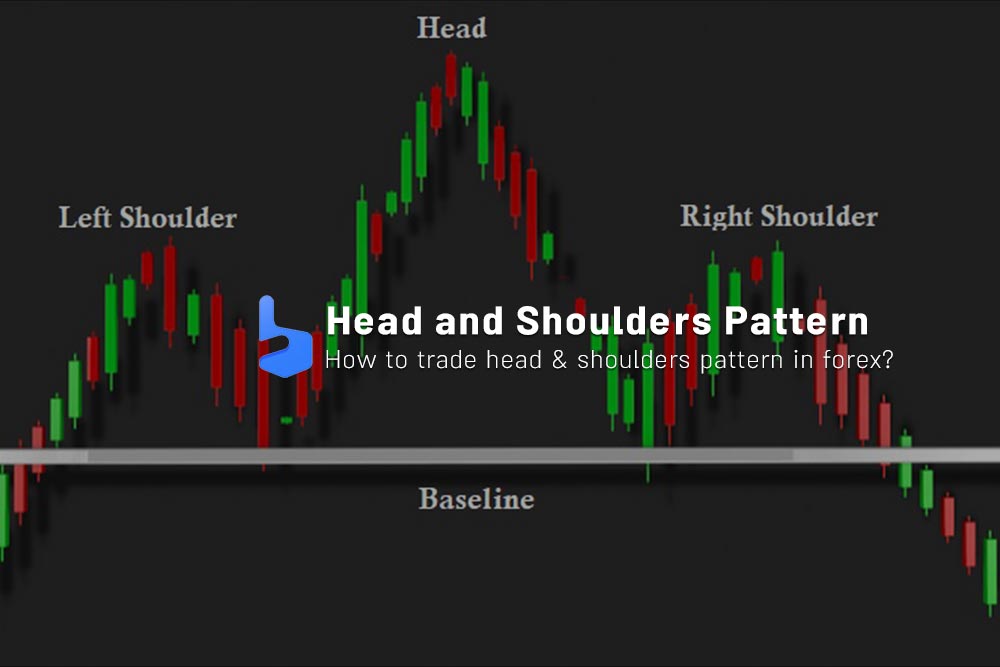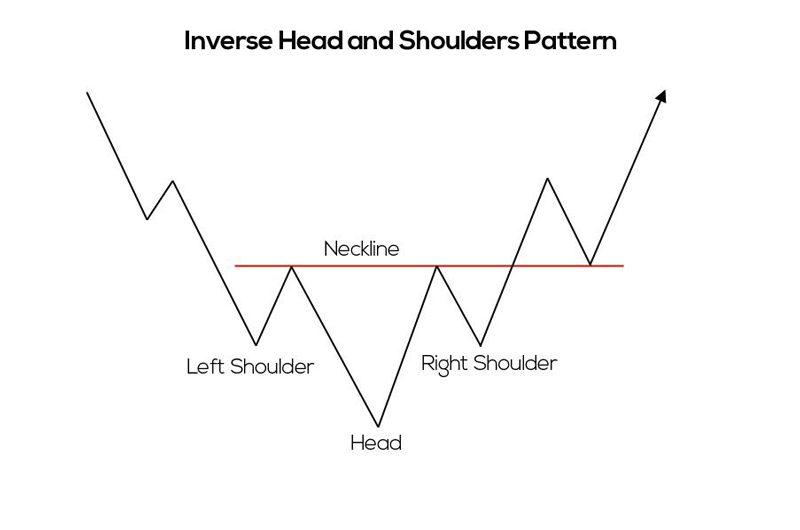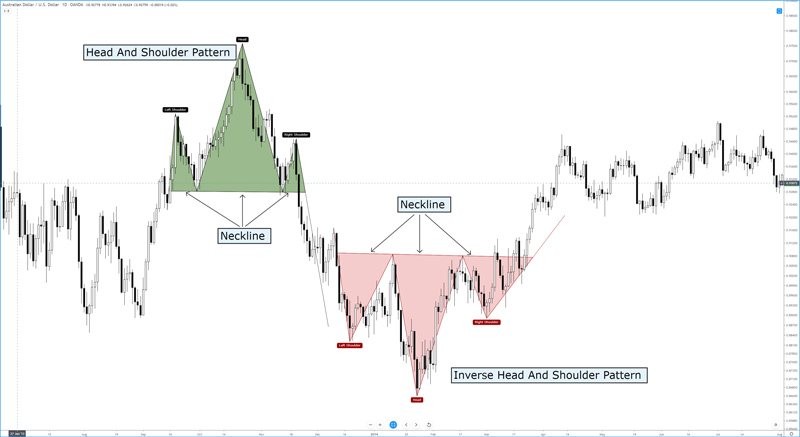What you are about to read:
The Head and Shoulders pattern is one of the most common chart patterns in technical analysis. It is considered a highly reliable pattern and is widely used by traders to identify trend reversals in the forex market. The Head and Shoulders pattern is a reversal pattern, meaning it indicates a change in trend. In this article, Brokerland provides a tutorial on this strategy for trading in the forex market and teaches it in detail.
What is a Head and Shoulders Pattern?
The Head and Shoulders pattern is a technical analysis pattern that resembles the human head and shoulders, hence its name. It consists of three Highs or Lows, with the middle high or low being the highest or lowest. The first and third highs or lows have similar heights and form the shoulders, while the second high or low forms the head.
In an uptrend, the left shoulder is formed with an increase in price, followed by a decrease. The head is formed with a higher peak, followed by a decrease in price, and the right shoulder is formed with a lower peak, followed by a decrease in price. Similarly, in a downtrend, the pattern is reversed. The left shoulder is formed with a decrease and, after that, an increase in price. The head is formed with the lowest trough, followed by an increase in price, and the right shoulder is formed with the highest trough, followed by an increase in price. The diagram below illustrates these explanations.
The Head and Shoulders pattern is considered a highly reliable pattern because it indicates a change in the direction of the trend. When the price breaks below the neckline, which serves as a support level and connects the bottoms of the left and right shoulders, it signals the end of an uptrend and the possibility of a downtrend starting. Conversely, when the price breaks above the neckline in a Head and Shoulders pattern, it signals the end of a downtrend and the possibility of an uptrend beginning.
How to Trade Head and Shoulders Pattern for Forex?
Previously, we discussed the use of patterns and other strategies such as the Flag pattern or wedge pattern in Forex trading. Now that we are familiar with the concept of the Head and Shoulders pattern in Forex, traders should follow a few simple steps to utilize it in the market:
Step 1: Identify the Head and Shoulders Pattern
The first step is to identify the Head and Shoulders pattern on the Forex chart. This can be done by looking for three peaks or troughs, with the middle peak or trough being the highest or lowest. The left and right peaks or troughs should have similar heights and form the shoulders, while the middle peak or trough forms the head.
Step 2: Wait for the Neckline to be Broken
The second step is to wait for the neckline to be broken. The neckline is a support level created by connecting the bottoms of the left and right shoulders. If you have any questions about how to draw support and resistance levels, we have explained it in detail in previous articles.
When the price breaks below the neckline in a Head and Shoulders pattern, it signals the end of an uptrend and the possibility of a downtrend starting. Conversely, when the price breaks above the neckline in an Inverse Head and Shoulders pattern, it signals the end of a downtrend and the possibility of an uptrend beginning.
Step 3: Set a Stop Loss Order
The third step is to limit trade risk by placing a stop-loss order. The stop-loss should be placed above the neckline in the regular Head and Shoulders pattern and below the neckline in the Inverse Head and Shoulders pattern.
Step 4: Determine a Profit Target
The fourth step is to set a profit target based on the distance between the head and the neckline. This distance is known as the “measured move” of the pattern and indicates the price movement after the pattern confirmation. For example, if the distance between the head and the neckline is 100 pip in forex, the profit target will be 100 pips below the neckline in the regular Head and Shoulders pattern and 100 pips above the neckline in the Inverse Head and Shoulders pattern.
Step 5: Manage Your Trade
The fifth step is trade management. Traders can manage the trade by adjusting the stop-loss even when the price has moved in their favor within the stop-loss distance. This means that if the stop-loss is set at 50 pips and the price has moved 50 pips in their favor, they can move the stop-loss to the break-even point to eliminate trade risk.
Traders can also exit the trade by taking partial profits at specific levels. For example, when the price reaches half of the measured move, they can close 50% of the position and then trail the stop-loss on the remaining position to capture any additional profits.
It is crucial to note that, as always emphasized, while the Head and Shoulders pattern is considered a highly reliable pattern, it is not foolproof. Traders should always use risk management techniques such as stop-loss orders and position sizing to limit risk and protect their capital against margin call, just as with any other pattern like the rectangle pattern.
Pros and Cons of the Head and Shoulders Pattern Strategy
Like any trading strategy, the Head and Shoulders pattern has both advantages and disadvantages. Here are some of them:
Pros:
- Highly Reliable: The Head and Shoulders pattern is considered a highly reliable pattern that can accurately indicate a change in trend.
- Clear Entry and Exit Points:This pattern provides clear entry and exit points for traders, making trade planning and execution straightforward.
- Defined Risk and Reward: By using the distance between the head and the neckline to determine profit targets, traders can define their risk and reward for a trade.
- Applicable Across Timeframes: The pattern can be applied across different time frames, from short-term charts like 15-minute and 1-hour charts to long-term charts like daily and weekly charts.
Cons:
- False Signals:Like any trading strategy, the Head and Shoulders pattern can generate false signals. Traders need to be able to distinguish between genuine and false signals and use additional analysis to confirm the pattern’s validity.
- Limited Profit Potential: The profit potential of the Head and Shoulders pattern is limited by the distance between the head and the neckline. This means that traders may lose potential profits if the price continues to move in their favor after reaching the profit target.
- Need for Patience and Discipline: This pattern requires patience and discipline to wait for the pattern to fully develop and the neckline to be broken. Impatient or undisciplined traders may enter or exit trades too early, resulting in losses.
- May Not Work in All Market Conditions: The Head and Shoulders pattern may not be effective in all market conditions, such as periods of low volatility or when the market is ranging.
Conclusion
This Brokerland article to learn Forex introduces another pattern called the Head and Shoulders pattern for trading in the market. It is considered a highly reliable pattern widely used by Forex traders to identify trend changes. By following a few simple steps, traders can identify the pattern, wait for the neckline to break, set a stop-loss order, determine a profit target, and manage the trade to achieve profits.
It is essential to remember that no trading strategy is 100% foolproof, and traders should always use risk management techniques and risk/reward ratio to limit their risk and protect their capital. With proper risk management and a thorough understanding of this pattern, traders can increase their chances of success in the Forex market.












